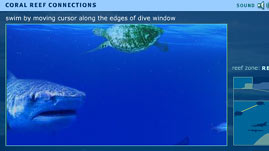Coral reefs are some of the most productive ecosystems on the planet. Of these, Australia's Great Barrier Reef is the largest and most diverse. This 1,200-mile-long chain of islands, which includes almost 3,000 individual reefs, is the largest structure on earth made by living organisms. Over millions of years, countless generations of tiny coral polyps have secreted layer upon layer of calcium carbonate and produced homes for themselves and for thousands of other species.
The creatures that inhabit the Great Barrier Reef didn't one day stumble upon this massive structure and decide it was a good place to live. Their species evolved
with the reef. But if the evolution of a single species is a difficult concept to grasp, how does one begin to understand the evolution of an entire ecosystem? How on earth does such amazing biodiversity arise?
The evolutionary processes that occur in reefs are no different from those that take place in less complex habitats. Over vast periods of time, species change -- sometimes becoming entirely new species -- in response to pressure from their environment. This pressure might stem from changes in physical factors like climate, water temperature, and water quality, as well as from interactions with other plants and animals.
On reefs, interactions with other organisms can take several different forms. Competition is probably the most common interaction. It may take place between members of the same species or across species. In short, it is the struggle against others to acquire the resources needed to survive and reproduce. Those individuals that compete most effectively typically live longer and produce more young. Over time, in response to competitive pressure, species evolve to become better at utilizing resources in their environment.
Predator-prey relationships are probably the second most common types of interaction on reefs. Unlike plants, animals are not capable of making their own food and must eat other organisms to survive. Reef creatures are no exception; they face a nearly constant struggle to find and capture food, while attempting to avoid being eaten by predators larger than themselves. Interactions between predators and prey often cause the organisms involved to evolve; prey species become better at avoiding predators, and predators become better at catching their prey.
Commensalism and mutualism are two similar forms of interaction between species. Unlike predation or parasitism, these types of relationships are cooperative, benefiting at least one of the species involved while not harming the other. Over time, commensal or mutualistic species may evolve to become more efficient in their cooperative relationships. For example, a host species may evolve an internal environment that is more suitable for the organisms that inhabit it. In return, its partner species will be more productive and benefit its host more.


 Loading Standards
Loading Standards Teachers' Domain is proud to be a Pathways portal to the National Science Digital Library.
Teachers' Domain is proud to be a Pathways portal to the National Science Digital Library.
